

Vol. 41 (Issue 03) Year 2020. Page 28
GERASIMOV, Alexey Nikolaevich 1; GROMOV, Evgeniy Ivanovich 2; GRIGORYEVA, Oksana Petrovna 3; SKRIPNICHENKO, Yurii Sergeevich 4 & KAPUSTINA Elena Ivanovna 5
Received: 15/10/2019 • Approved: 26/01/2020 • Published 06/02/2020
ABSTRACT: The aim of the article is to study theoretical principles and create a set of practical recommendations for substantiating managerial decisions based on improving scenario forecasting tools that can identify trends and factors affecting the agricultural sector, present the results of forecasting and analytical calculations. This article calculates the forecast values of the main development indicators of individual agricultural sub-sectors of the Stavropol Territory based on the construction of spatially dynamic econometric models. |
RESUMEN: El objetivo del artículo es estudiar los principios teóricos y crear un conjunto de recomendaciones prácticas para fundamentar decisiones gerenciales basadas en la mejora de las herramientas de pronóstico de escenarios que pueden identificar tendencias y factores que afectan al sector agrícola, presentar los resultados de los pronósticos y los cálculos analíticos. Este artículo calcula los valores pronosticados de los principales indicadores de desarrollo de subsectores agrícolas individuales del Territorio de Stavropol a partir de la construcción de modelos econométricos espacialmente dinámicos. |
The process of global integration of economic relations is accompanied by an exacerbation of regional differentiation processes, which contributes to the identification of many specific evolutionary branches of local markets of various sizes, levels of development, and the nature of the products that appeal to them. This circumstance fully relates to the development of local markets for agricultural products in modern Russia, which are focused on meeting social needs for products that form the basis of the nutrition of the population of the respective regions. At the same time, the sustainable development of these markets provides a solution to the priority national task of ensuring the food security of the Russian Federation. In the practice of making managerial decisions at the regional level in recent years, considerable attention has been paid to the development and implementation of strategic program documents. So, at the federal level, the State Program for the Development of Agriculture and the Regulation of Agricultural Products, Raw Materials and Food Markets for 2013-2020 is being implemented, and in the Stavropol Territory the program “Development of Agriculture” is being implemented. The need to improve the management system of individual sectors of the region's economy is associated with the heterogeneity of regional development, uneven distribution of productive forces, as well as the challenges of modernization and achieving sustainable economic growth. The system of making managerial decisions in the field of agricultural economy at the regional level requires further study and development of practical recommendations. In this regard, it is necessary to study the theoretical provisions and create a set of practical recommendations for substantiating management decisions based on improving scenario forecasting tools that can identify trends and factors affecting the agricultural sector, present the results of forecasting and analytical calculations G Galazova S.S. (2018) Kuz'minov A.N.(2017)
Sustainable development of certain local markets in the face of uncertainty and increased risks requires the testing of scientifically sound modeling and forecasting techniques, the use of formalized methods to identify the main patterns of development and supporting trends, which make it possible to objectively take into account prevailing business conditions and changing market.
A correct assessment of objective trends, scientifically based application of modeling methods, and the development of a set of forecast development scenarios are very important for regional agricultural product markets that have significant growth potential. In this regard, the study of trends and patterns of development of the regional agricultural market is relevant for modern Russia.
At present, the use of forecasting methods is a rather relevant condition for the stable and sustainable development of agriculture. In this case, an objective assessment of the current situation in the industry at the regional level should be taken into account, since the efficiency of the economic activity of agricultural producers depends on this. Of particular importance in this case are the methods of economic and mathematical modeling and adaptive forecasting, as a result of which it becomes possible to timely correct regional development plans.
Taking into account the need to improve the management system of individual sectors of the region’s economy, due to the heterogeneity of regional development, the imbalance of spatially localized systems, the uneven distribution of productive forces, as well as the tasks of modernization, achieving sustainable economic growth, and increasing the efficiency of regional production, we proposed its conceptual model for the Stavropol Krai (figure 1).
The scientific approach, along with the formulation of the general objectives of this study in accordance with the needs of managing the agricultural economy, requires a description of the methodology used in the process of cognition and formalization of the models used to solve the problems posed. However, in the research methodology, methods and models are necessary as tools for developing managerial decisions, formulating conclusions substantiating strategic plans and a system of measures Rossinskaya M.V. et al., (2019) Yarkova T.M. et al., (2019)
The econometric approach to modeling and forecasting the main indicators of the state and development of agriculture allows, ultimately, choosing the best option for making managerial decisions and ensures the highest efficiency of the proposed measures. In our opinion, the methodology of modeling and forecasting the main indicators of the state and development of crop production should contain a number of successive stages:
1. Goal setting, justification of the need to develop and use complex econometric models;
2. Formalization of the system of productive and factor indicators of the model;
3. The formation of the initial research information base: the establishment of units and the observation period;
4. The specification of the equations of dependence of the complex econometric model in the context of individual types of crop production;
5. Using step-by-step procedures for selecting significant factor variables for each equation of the system;
6. Parameterization of the econometric equations of the system using special methods for estimating parameters depending on the degree of identifiability of the complex model, checking their practical significance;
7. The use of statistically significant econometric models of the system for extrapolating the values of endogenous variables characterizing the state of the studied types of crop production;
8. Analysis of the results of modeling and scenario forecasting of the studied indicators in order to develop a set of measures to manage the further development of the crop industry in the Stavropol Territory.
9. Monitoring the implementation of indicative indicators of the development of the crop industry in the Stavropol Territory, planned by state programs for the development of the industry for the medium term.
10. The use of methods of indicative planning of the industry for the long term taking into account the obtained simulation results.
Figure 1
The conceptual model of the regional economy management system
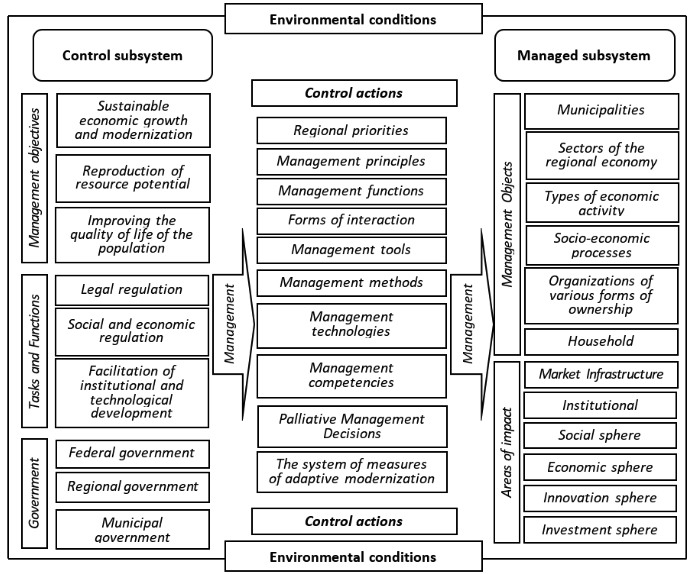
Source constructed by the authors
The use of econometric models makes it possible to better understand the processes and phenomena under study, thereby helping to formulate objective conclusions based on the results obtained and build more accurate forecasts of the necessary indicators. Thus, the econometric approach in accordance with the methodology used allows you to choose the best option for making a managerial decision that ensures the greatest effectiveness of the measures taken in the region.
Since the aim of the study is to study the patterns and identify trends in the development of the crop industry in the Stavropol Territory, we consider it appropriate to identify the following groups of endogenous variables:
Ya1 – grain production in agricultural producers, thousand tons;
Yb1 – grain was sold by agricultural producers, thousand tons;
Ya2 – production of sunflower seeds by agricultural producers, thousand tons;
Yb2 – sold sunflower seeds by agricultural producers, thousand tons;
Ya3 – sugar beet production by agricultural producers, tons;
Ya5 – grape production by agricultural producers, thousand tons;
Ya11 – pork meat production by agricultural producers, tons;
Yb5 – sold grapes by agricultural producers, thousand tons;
Yb10 – sale of beef meat by agricultural producers, tons;
Yb12 – sold mutton meat by agricultural producers, tons;
Xa2 – the level of profitability (loss ratio) of sunflower,%;
Xb1 – production cost of 1 ton of grain, rub .;
Xc1 – average prices for 1 ton of grain, rub;
X2 – current assets, million rubles;
X4 – average per capita cash income per month, rubles;
X5 – investment in fixed assets of agriculture, million rubles.
The stated goals and objectives of this study, an analysis of the current situation in the plant growing industry of the Stavropol Krai, as well as the system of productive and factor variables of the complex econometric model justified above, allowed us to propose a structural-logical diagram of the relationship and interdependence of groups of endogenous variables of production, implementation and main groups of exogenous variables (figures 2-3).
In accordance with the proposed research algorithm, as well as the constructed system of productive and factor indicators, the relationship is assessed within the framework of the proposed structural logical scheme at the specification stage using multivariate linear dependencies, which are advisable to consider in the form of multiple linear regression equations, due to the simplicity of the subsequent interpretation of the results Bogoviz A.V. et al., (2018), Kiseleva N.N. (2017)
In general terms, the model of production and sale of the main types of crop production of the Stavropol Krai can be represented as:


Figure 2
Block diagram of the relationships of variables
for the model of production and sale of crops
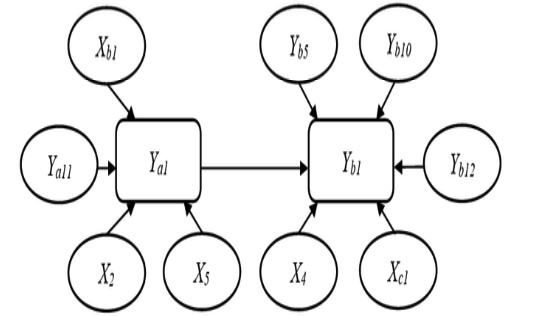
Source: Authors
Source: Constructed by the authors
-----
Figure 3
A block diagram of the relationships of variables
for the model of production and sale of sunflower
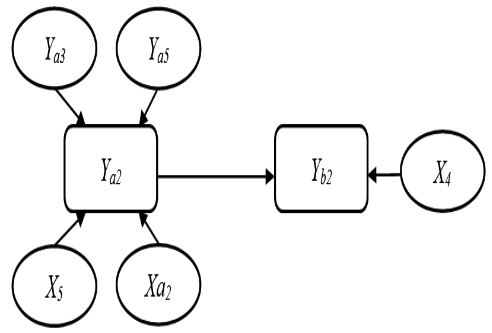
Source: Constructed by the authors
In accordance with the proposed methodology, it is necessary to make step-by-step selection of significant factor variables in each equation of the system in order to improve their practical significance. The fact is that at the initial stage, when forming a system of indicators, it included all the possible conditions for the functioning of local markets for crop production. However, the main goal of constructing complex econometric models is not so much to assess the relationships between all the selected indicators (both strongly and weakly interrelated with the effective ones), as modeling the studied processes and phenomena only from the most significant factors that have a really strong effect on endogenous variables Galazova S.S. et al., (2018) Kiseleva N.N. (2018)
Computational procedures in accordance with the proposed methodology for modeling and forecasting the results of the functioning and development of local regional agro-food markets were performed using the IBM SPSS Statistics application package.
It is advisable to parameterize the regression dependences of the production and sale of crops on a set of exogenous variables to obtain objective results on the basis of systems of simultaneous equations that must be built separately for each of the types of agricultural products under consideration.
The system of equations obtained as a result of the selection of significant factor variables of the models of production and sale of grain has the following structural form:
The system obtained as a result of the selection of significant factor variables of the models of production and sale of grain crops has the structural form:
Table 1
Statistical correctness of models for cereal crops
Model |
R2 |
S |
F |
Sig. |
Grain Crops Production Model |
0,992 |
9,42 |
167,59 |
0,000 |
Grain Crops Sale Model |
0,959 |
9,8 |
123 |
0,000 |
The value of the Fisher F-test, characterizing the ratio of factor and residual variances, allows us to conclude that the obtained models of production and sale of crops are statistically significant. The highest value of the multiple coefficient of determination was obtained at this stage for equation A; in accordance with it, grain production by 99.2 % was explained by a variation of factors included in the model. In turn, sales volumes are explained by the action of factors selected in model B by 95.9% Ashkhotov A.M. (2018) Yarkova T.M. (2019) [1, 17].
Computational procedures in accordance with the proposed methodology for modeling and forecasting the results of the functioning and development of local regional agro-food markets were performed using the SPSS application package.
Figure 4
Forecast of grain production by agricultural producers
of the Stavropol Krai in 2019-2030
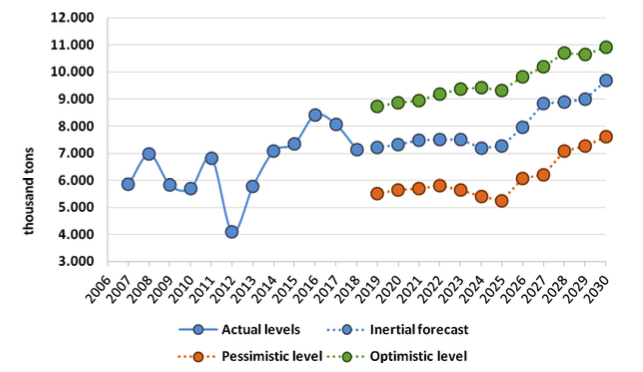
Source: authors
According to the inertial scenario, forecasted values of grain production by agricultural producers of the Stavropol Krai demonstrate a stable growth of this indicator until 2023. In 2025, a slight decline in production is forecasted to reach 7.3 million tons, after which production volumes will grow again and amount to 9.7 million tons by 2030 (Figure 4).
The sales volumes of grain under the inertial scenario (Figure 5) have a steady growth, but their values are less than those of production volumes: by 2023 they will amount to 7 million tons. A decrease in sales growth is forecasted in 2024 to the level of 6.4 million tons, which will then be replaced by a positive trend - up to 2030.
Figure 5
Forecast of sales volumes of grain crops by agricultural producers
of the Stavropol Krai in 2019-2030
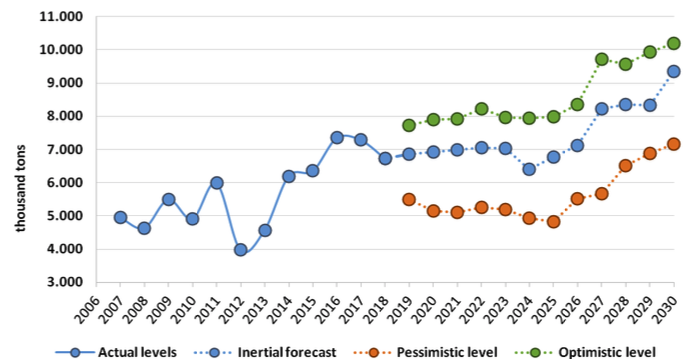
Source: authors
The forecast values of prices for crops demonstrate steady growth, which in 2030 will lead to a value of 15 000 rubles per 1 ton (Figure 6).
Figure 6
Forecast of prices for crops sold through all channels
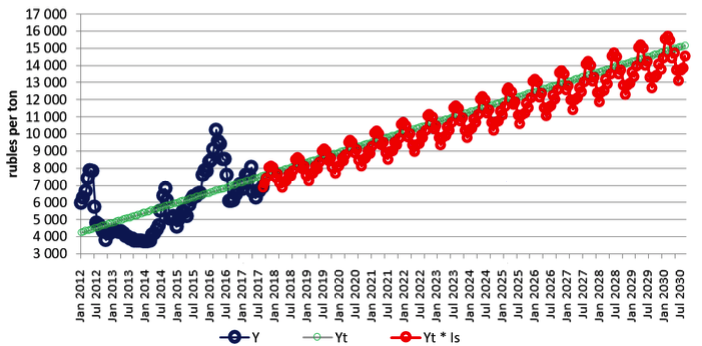
Source : authors
The system of equations obtained as a result of the selection of significant factor variables for the models of production and sale of sunflower seeds has a structural form and is given below:
Table 2
Statistical correctness of models for sunflower seeds
Model |
R2 |
S |
F |
Sig. |
Sunflower Seeds Production Model |
0,979 |
1,56 |
290,7 |
0,000 |
Sunflower Seeds Sale Model |
0,966 |
12,76 |
57,45 |
0,001 |
The value of Fisher's F-test indicates a high statistical significance of the constructed models. The highest value of the multiple coefficient of determination was obtained at this stage for equation A, in accordance with it the production of sunflower seeds was explained by 97.9 % by a variation of the factors included in the model. In turn, sales volumes are explained by the action of factors selected in model B by 96.6 %.
Evaluation of the forecast values of volumes of sunflower seed production according to the inertial scenario allows us to conclude about stable development until 2023. The presence of slight production drops has been extrapolated, for example, to the level of 605 thousand tons in 2025, but by 2030. Sunflower production will increase and amount to 756 thousand tons. The optimistic scenario involves the growth of production volumes up to 826 thousand tons in 2030, pessimistic - 684 thousand tons (Figure 7).
Figure 7
Forecast of sunflower seed production by agricultural producers
of the Stavropol Krai in 2019-2030
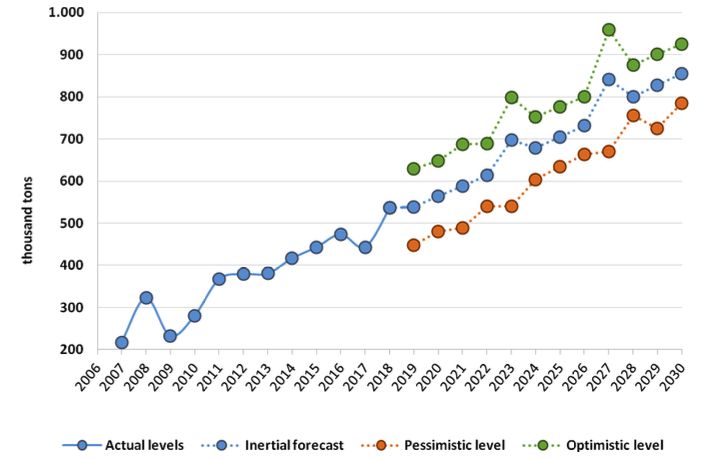
Source: authors
The sales volumes of sunflower seeds under the inertial scenario lag behind production volumes, so, by 2023 they will amount to 629 thousand tons. A slight decline in sales volumes is forecasted to reach 581 thousand tons in 2025, which will be replaced by an increase to 702 thousand tons by 2030. According to an optimistic scenario, sunflower sales will amount to 803 thousand tons in 2030, and pessimistic - 464 thousand tons (Figure 8).
Figure 8
Forecast of sales volumes of sunflower seed by agricultural producers
of the Stavropol Krai in 2019-2030
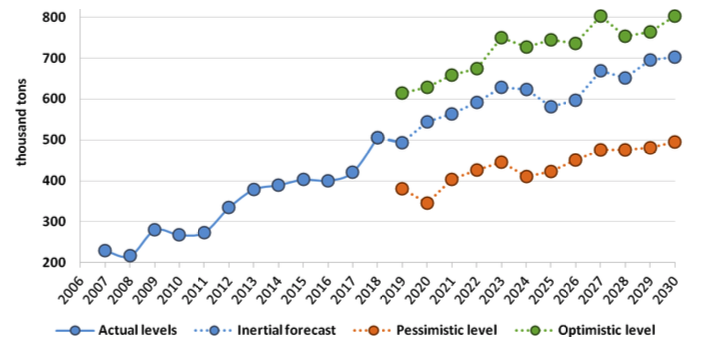
Source: authors
A study of the forecast values of the price of sunflower allows us to conclude about a stable increase in prices for products, which in 2030 will cost 43 300 rubles for 1 ton (Figure 9).
Figure 9
Forecast of prices for sunflower seeds sold through all channels
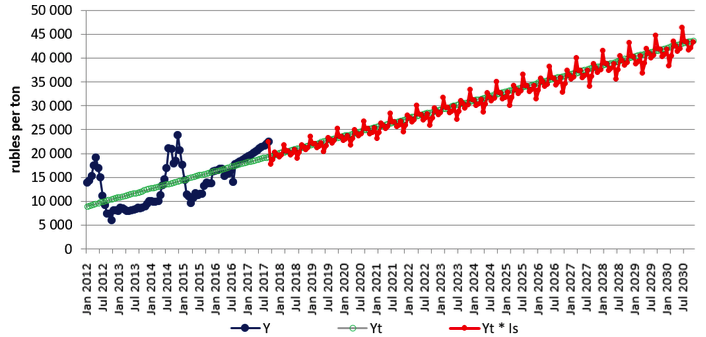
Source: authors
Consideration of the seasonal component in the forecast assessment of the price level allowed us to establish that the maximum price is expected in June, the minimum - in September.
Along with the development and justification of economic programs and strategic plans, an important task of regional government bodies is to study the results of the implementation of strategic programs and measures, monitor the achievement of indicators and their correction and adaptation based on the results [3, 18].
The proven scenario forecasting technique, based on an econometric approach to modeling the main indicators of socio-economic development, should be used at all levels of government and become an important tool in the development and correction of existing economic programs and strategic plans of both national and regional, and sectoral significance.
To predict the development of the crop production industry in the territorial framework of the Stavropol Territory, an econometric approach was used in the work, which allows scientifically substantiating the assessment of the identified relationships and obtaining forecasts of indicative indicators. In addition, the econometric approach allows you to choose the best option for making managerial decisions and ensures the highest efficiency of the proposed activities in accordance with the strategic goals and objectives of development programs Gorbunov A.P. et al., 2019) Litvinova T.N. (2017)
The study of the component of the region’s economy management system, carried out in the framework of this study, allows us to conclude that it is necessary to implement tools for scenario forecasting of economic activity of regional economic entities for timely correction of the development directions of various sectors of the economy.
The paper proposes a conceptual model of the region’s economy management system, the most important element of which is the management subsystem that activates the management processes and performs managerial actions on another element that is complementary to it - the managed subsystem Kuzminov A.N. et al. (2018) Tatuev A.A. (2010)
As a result of the application of advanced extrapolation methods, multivariate development trajectories of the production of certain types of crop products were obtained, which made it possible to identify a steady increase in the production and sale of grain crops and sunflower seeds in the framework of optimistic, inertial and pessimistic scenarios Nagoev A.B. (2019) Tatuev A.A. (2011)
Based on the results obtained, monitoring was carried out of the compliance of the achieved and forecasted levels of production of these crops with the corresponding indicators of targeted federal and regional state programs, the implementation of which is aimed at increasing the main indicators of the regional agribusiness. At the same time, the target indicators of the State program of the Stavropol Krai “Development of Agriculture” are in the zone of inertial or optimistic forecast options.
In order to increase the effectiveness of the economic activity of crop production in the Stavropol Krai, the following recommendations are presented in the work:
1. Introduce in the Stavropol Krai a conceptual model of the region’s economy management system.
2. To use in the practice of government bodies models of strategic management of the agricultural economy.
3. To apply a conceptual model for implementing a set of measures of adaptive and tactical correction of strategic plans for sectoral programs of agricultural regions.
Ashkhotov A.M., Bogoviz, A.V., Taranov, P.M., Shuvaev, A.V. (2018). Directions for the implementation of the competitive advantages of regional economic. Financial Economics..No 7. P. 1652-1654.
Bogoviz, A.V., Taranov, P.M., Shuvaev, A.V. (2018). Innovational tools for provision of food security through state support for the agro-industrial complex in the conditions of digital economy . Advances in Intelligent Systems and Computing.. Т. 622. P. 659-665.
Dzhukha, V.M., Kokin, A.N., Li, A.S., Sinyu, T.Y. (2017). Research and development intensity in business: Russia and EU. European Research Studies Journal. Т. 20. № 1. P. 64-76.
Galazova, S.S., Romanova, T.F., Otrishko, M.O., Malyuga, A.L. (2018). Development of health care financial provision system: experience in the Russian Federation and in other countries. European Research Studies Journal.. Т. 21. № S2. P. 53-62.
Galazova, S.S., Kasaeva, T.V., Ashkhotov, A.M., Rokotyanskaya, V.V., Evetskaya, S.V. (2018). Functional patterns and operating conditions of regional socio-economic systems in the Russian Federation . Amazonia Investiga.. Т. 7. № 17. P. 570-578.
Gorbunov A.P. Kasaeva, T.V., Kolyadin, A.P., Tokova L.D. (2019). Forecasting the economic state of a bank on the basis of bankruptcy indicator . Advances in Intelligent Systems and Computing.. Т. 726. P. 639-645.
Kiseleva, N.N., Ashkhotov, A.M., Shanin, S.A>, Akindeev, Ju. A., Bozieva. I.A. (2018). Regional specifics of innovative development of socio-economic systems in the Russian Federation . N.N. Amazonia Investiga.. Т. 7. № 16. P. 351-360.
Kiseleva, N.N., Orlyanskaya, A.A., Tlisov, A.B.,Tatuev, A.A., Gukasova, N.R. (2017). Territorial imperatives of industrial production development . Journal of Advanced Research in Law and Economics. Т. 8. № 2. P. 469-476
Kuzminov, A.N., Korostieva, N.G., Dzhukha, V.M., Ternovsk, O.A. (2018). Economic coenosis stability: methodology and findings. A.N. y Contemporary Studies in Economic and Financial Analysis. Т. 100. P. 61-70.
Kuz'minov A.N. , Dzhuha, V.M., Ternovsky, O.A. (2017). Methodology of structural stability management for industrial enterprises .A.N. European Research Studies Journal. Т. 20. № 3B. P. 260-268.
Litvinova, T. N., Kulikova, E. S., Kuznetsov, V.P., Taranov, P.M. (2017). Marketing as a determinant of the agricultural machinery market development / T.N. Contributions to Economics. № 9783319606958. P. 465-471.
Nagoev A.B., Rokotyanskaya, V.V., Stolyar, I.V., Kulyakina, E.L. (2019). Role of the state in the distribution and redistribution of cash and agricultural resources in the regions of the Russian Federation . Iraqi Journal of Agricultural Sciences. 2019. Т. 50. № S. P. 143-151
Rossinskaya M.V., Savelieva, N.A, Rokotyanskaya, I.V. (2019). Tools for improving operational risk management in agriculture. Iraqi Journal of Agricultural Sciences. 2019. Т. 50. № S. P. 134-142.
Tatuev A.A. (2011). Directions of the transformation of regional development . Terra Economicus. Т. 8. № 3-4. P. 97.
Tatuev A.A. (2010). The main objectives of the modernization of spatial forms of organization of the regional economy . Issues of Economics. No 2. P. 113.
Yarkova, T.M., Svetlakov, A.G. (2013). Definition of state support for the generation of food stocks in the region in the WTO format . Economics of the region. No. 4 (36). P. 157-167.
Yarkova, T.M. (2019). The role of the WTO in the development of the Russian agri-food complex: comparative analysis. Bulletin of the Kursk State Agricultural Academy. 2019.No 2. P. 194-200.
Yarychiv, N.U., Kuznetsov, V.I., Rokotyanskaya, V.V., Usanov, V.Yu., Safronova, Yu.V. (2019). Monitoring living standards of the population of the region. Revista Inclusiones. 2019. Т. 6. № S4-6. P. 306-317.
1. Doctor of Economic Sciences, Professor, Faculty of Accounting and Finance, Stavropol State Agrarian University, Stavropol, Russia. E-mail: gerasimov_77_77@mail.ru
2. Doctor of Economic Sciences, Professor, Faculty of Accounting and Finance, Stavropol State Agrarian University, Stavropol, Russia. E-mail: gromei@mail.ru
3. Candidate of Economic Sciences, Docent, Faculty of Accounting and Finance, Stavropol State Agrarian University, Stavropol, Russia. E-mail: ksuta_stav@mail.ru
4. Candidate of Economic Sciences, Docent, Faculty of Accounting and Finance, Stavropol State Agrarian University, Stavropol, Russia. E-mail: maxim-84@list.ru
5. Candidate of Economic Sciences, Docent, Faculty of Accounting and Finance, Stavropol State Agrarian University, Stavropol, Russia. E-mail: elena79-26reg@mail.ru
[Index]
revistaespacios.com

This work is under a Creative Commons Attribution-
NonCommercial 4.0 International License